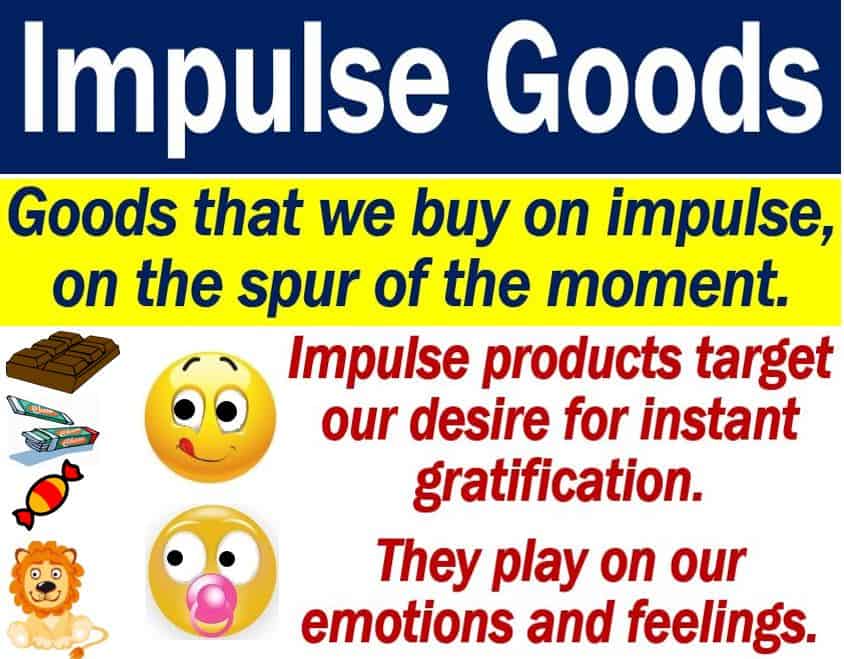Impulse Goods are products that people buy on impulse, i.e., without planning to do so. Retailers commonly place these items near the checkout counters of supermarkets, filling stations, and other retail outlets. Products such as chocolate, snacks, chewing gum, and candy, for example, are impulse goods.
Impulse buyers or impulse purchasers are people who buy or decide to buy things on the spur of the moment.
We refer to the act of suddenly deciding to buy something and acting on that desire impulse buying. We also call it an impulse purchase.
Impulse goods play on people’s feelings and emotions. In other words, people do not buy them as a result of logical and strategic thinking, but because of something they feel.

Essential, emergency, and impulse goods
Impulse goods contrast with essential goods or staple goods. Essential goods are those we need and that we usually purchase because we had planned to.
Bread, eggs, soap, toothpaste, and soap, for example, are essential goods. They are not goods that the consumer decides to purchase on the spur of the moment.
Any product that represents a dominant portion of our diets is a staple good.
Convenience stores sell staple goods alongside impulse goods and emergency goods.
Flashlights, candles, and umbrellas, for example, are emergency goods. We buy them when we suddenly or desperately need them, i.e., in an emergency.
We need candles when there is a blackout. If I get caught out in the rain, an umbrella suddenly becomes an emergency good for me.
Impulse goods and marketers
Marketers exploit our desire for instant gratification with products that they know trigger our impulse buying instincts.
Those instincts, if they can manipulate them successfully, help boost their company’s revenue. Revenue is the income a business makes from the sale of goods or services.
Sellers of chocolate, candy, mints, and chewing gum make a significant proportion of their sales from impulse buying.
Marketers place impulse goods strategically, usually at checkout aisles in supermarkets. They also place them near the cash tills at 24×7 stores and filling stations.
They know that many adults go shopping with their backup impulse buyers, i.e., their children. Nobody’s desire for instant gratification is as strong as a child’s. Therefore, they often place those goods lower down, i.e., at a child’s eye level.
Online shopping
As online shopping grows, will the sale of impulse goods decline? Online shopping means purchasing things on the Internet.
When we are shopping for our groceries online, we are not standing at the checkout aisle when it is time to pay.
Perhaps marketers will find a way to manipulate our emotions and feelings when we shop online.
In fact, with advancements in digital marketing, companies are increasingly using personalized advertisements and time-limited offers to create a sense of urgency and encourage impulse buys even in the digital realm.
Additionally, the integration of social media platforms with e-commerce sites presents products in a casual browsing environment, further tapping into the impulse purchasing behavior of consumers.
“Impulse goods,” examples sentences
Here are seven sentences that demonstrate how “impulse goods” can be mentioned in various contexts: The sentences also illustrate the various ways in which impulse goods play a role in consumer behavior and retail strategy:
- “Upon checking out, I noticed the rack of sunglasses, a classic example of ‘impulse goods’, and couldn’t resist grabbing a pair.”
- “The store’s layout was carefully designed so that ‘impulse goods’ like candy bars and magazines were right by the cashier, tempting customers as they wait to pay.”
- “During the holidays, ‘impulse goods’ such as seasonal decorations see a surge in sales due to their eye-catching displays and limited-time availability.”
- “Impulse goods are not limited to physical stores; online retailers use flash sales and homepage banners to promote these products.”
- “In the quarterly report, the sales team highlighted an increase in profits attributed to strategically placed ‘impulse goods’ at the end of each aisle.”
- “The convenience store’s revenue from ‘impulse goods’ significantly contributes to their bottom line, proving the effectiveness of product placement.”
- “During the focus group, customers admitted that ‘impulse goods’ often made up a surprising amount of their total shopping expenses.”
